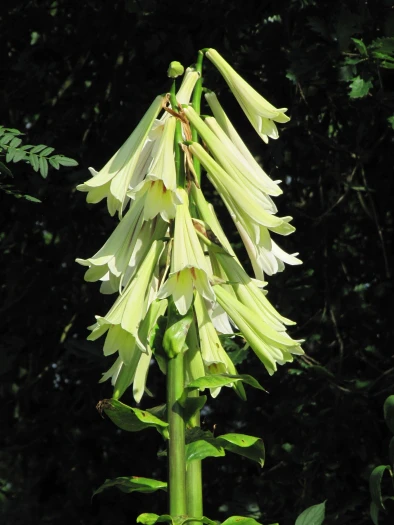Giant Himalayan Lily
(Cardiocrinum giganteum)
Giant Himalayan Lily (Cardiocrinum giganteum)
/
/

Leonora (Ellie) Enking
CC BY-SA 2.0
Image By:
Leonora (Ellie) Enking
Recorded By:
Copyright:
CC BY-SA 2.0
Copyright Notice:
Photo by: Leonora (Ellie) Enking | License Type: CC BY-SA 2.0 | License URL: https://creativecommons.org/licenses/by/2.0/ | Uploader: wallygrom | Publisher: Flickr |











Estimated Native Range
Climate Requirements for Paris, Texas
| This Plant | Your Site | Plant Suitability for Your Location | ||
|---|---|---|---|---|
| • Precipitation | 14" - 117" | 46" | Aquatic | Aquatic |
| • High Temp. | 48°F - 111°F | 94°F | Your summer temperatures are normal for this plant. | Excellent |
| • Low Temp. | 1°F - 56°F | 30°F | Your winter temperatures are normal for this plant | Excellent |
This plant should grow very well at your location without additional irrigation.
Summary
Cardiocrinum giganteum, commonly known as Giant Himalayan Lily, is a deciduous perennial bulb native to moist, cool temperate forests and grassy slopes in the Himalayas, southwestern China, Myanmar, and Nepal. It is the largest species among lilies, reaching up to 3.5 meters in height. The plant features a striking appearance with its large, fragrant, trumpet-shaped white flowers that can be 8 inches (20 cm) long, adorned with purple streaks and a greenish tinge on the exterior. The broad-ovate leaves are medium to dark green, measuring 12–15 inches (30–38 cm) in length. Flowering occurs in early to mid-summer, and the blooms are highly showy, making it a focal point in any garden.
The Giant Himalayan Lily is valued for its spectacular flowers and statuesque form, which can add a dramatic effect to woodland gardens and shaded borders. It is often used as a specimen plant due to its size and the visual impact of its blooms. While it requires consistent moisture, it is adaptable to various soil drainage conditions. After flowering, the plant dies back, but it produces offsets that will flower in subsequent years. Gardeners should be aware that it may take several years for a newly planted bulb to flower. It prefers cool, moist conditions and does not tolerate hot, dry climates well.CC BY-SA 4.0
The Giant Himalayan Lily is valued for its spectacular flowers and statuesque form, which can add a dramatic effect to woodland gardens and shaded borders. It is often used as a specimen plant due to its size and the visual impact of its blooms. While it requires consistent moisture, it is adaptable to various soil drainage conditions. After flowering, the plant dies back, but it produces offsets that will flower in subsequent years. Gardeners should be aware that it may take several years for a newly planted bulb to flower. It prefers cool, moist conditions and does not tolerate hot, dry climates well.CC BY-SA 4.0
Plant Description
- Plant Type: Bulb
- Height: 7-9 feet
- Width: 2-3 feet
- Growth Rate: Moderate
- Flower Color: White
- Flowering Season: Summer
- Leaf Retention: Deciduous
Growth Requirements
- Sun: Part Shade
- Water: Medium
- Drainage: Slow, Medium, Fast
Common Uses
Bee Garden, Butterfly Garden, Fragrant, Showy Flowers
Natural Habitat
Moist, cool temperate forests and grassy slopes in the Himalayas, southwestern China, Myanmar, and Nepal
Other Names
Common Names: Giant Lily
Scientific Names: Cardiocrinum giganteum, Lilium giganteum, Lilium cordifolium subsp. giganteum
GBIF Accepted Name: Cardiocrinum giganteum (Wall.) Makino